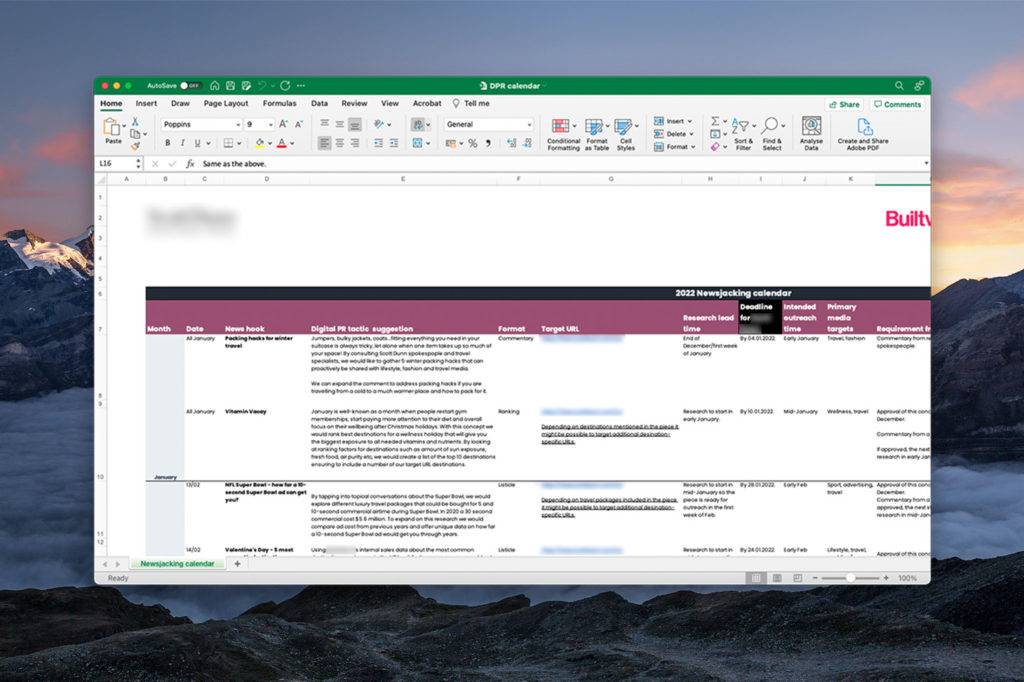Question 1: What is your understanding of Digital PR and link building?
It’s likely that your teams’ knowledge of digital PR and link building varies across markets. This can be due to things such as how markets are prioritised – where high priority markets have dedicated SEO and Digital PR teams, while smaller, lower priority markets may not.
If you’re going to successfully implement an international link building strategy, it’s important to first understand the level of knowledge relevant markets have so that you know what support and education might be required. Depending on the level of expertise, we’ve found workshops effective in encouraging an open dialogue and knowledge-sharing.
These are generally best held in two parts:
- Firstly, a session focused on revisiting SEO and link building fundamentals, explaining their direct correlation to market performance. Within this session, you can demonstrate various Digital PR tactics you’d aim to use which can spark ideas and serve as a springboard for the second session.
- The second session should be all about the practical, and implementation elements of link building. An exercise that many teams find useful involves analysing upcoming marketing and PR campaigns and thinking about ways they can be used for link building. Wider company initiatives such as partnerships, announcements, and new product launches can boost link building if planned with it in mind.
Education and marrying existing plans with link building helps local teams see the value of an SEO-first approach to activities in their region.

Question 2: Are you currently carrying out any Digital PR or link building activity?
We know that communication across markets isn’t always the best, so there’s a chance that there’s already link building activity taking place. Check in with your teams to understand if this is the case, and if so, how it’s performing and any learnings that could feed into your international strategy.
The phrase ‘if it’s not broken don’t fix it’ comes to mind, particularly if teams are successfully building links. But, if you’re building an international strategy, it’s likely that some tweaks will need to be made to achieve overall objectives – or at least highlight opportunities for efficiencies. Take the time to understand what the markets are doing, and lean on education to showcase and gain buy-in for what you’re trying to achieve.
On the flip side, if it comes to light that potentially harmful link building tactics are being used, this is a great opportunity to educate, and ensure best practice link building is put in place instead.
Question 3: What are the SEO priorities in your market?
This question is especially important when developing your Digital PR strategy. Building links to pages that don’t need links or aren’t optimised from an on-page perspective won’t lead you to the success you hoped for.
Each market has its unique SEO challenges that directly correspond to the search patterns of your audiences and the overall online landscape in the region. This means if you’ve developed a successful strategy in one market, it doesn’t guarantee the same strategy will work in another.
Work closely with your market teams to understand where opportunities lie. This can either come from business objectives, search trends, or analysing the activity of your competitors to highlight gaps and opportunities in the market. Using these insights will equip your local teams with a strategy that will truly make a difference to their bottom line.

Question 4: What might prevent Digital PR in your market?
If you’re reading this, it’s likely that you’ve tried to, or are thinking of implementing a cross-market Digital PR strategy and so potential roadblocks are something you want to avoid. Knowing the limitations that lie ahead means that you can successfully adjust your Digital PR strategy.
Typically, we find that roadblocks fall into three buckets:
- Market nuances: opportunities for link building in each market are dictated by the media landscape and tactics available. Being aware of these can save you time further down the line when you may have tried to implement strategies or tactics that simply won’t work in a certain market.
- Available resource: market teams, particularly smaller ones, can be stretched extremely thin. It’s important to understand what’s actually going to be achievable so that you can provide the right level of support, tailored strategy or implementation solutions.
- Internal roadblocks: as Digital PR undoubtedly requires talking to journalists and talking about the brand externally, it’s inevitable that broader marketing, PR, brand, and even compliance teams would need to be involved at some level. This is one of the most common roadblocks we see.
Understanding what teams are potential stakeholders in Digital PR activity from the get-go is important to successfully scale link building. In doing so you can manage expectations (both ways), educate and successfully collaborate. But this doesn’t happen overnight, especially if link building isn’t something that was done in the market historically.
We find that regular touchpoints help teams to align. Depending on each market’s preferences, a monthly or bi-monthly call to discuss the upcoming activity should suffice. Similarly, bringing teams into elements of strategic planning is a great way to gain buy-in and create efficiencies.
This could be simply inviting a market’s PR team to your next digital PR campaign ideation session.

Question 5: What are your preferred ways of working?
Hounding your already busy local teams with endless requests to review or action items, or filling up their calendar with calls that could have been emails isn’t going to help with buy-in or excitement for Digital PR.
Firstly, define what elements of Digital PR your market teams want and need to be involved in. This can help protect their resource and avoid hold-ups. Establishing key milestones in your strategy and running through these with your teams and requesting a ‘yes’ or ‘no’ to their involvement is a great way to do this.
An example of this could be whether they need to review and approve outreach lists or templates. Even reactive tactics like newsjacking can be planned into a calendar and approved ahead of key dates – detailing concepts, and support needed from local teams. This gives them full visibility and reduces the need for day-to-day involvement.
Secondly, work out the admin and communication methods that work best across multiple teams. Centralised documents like Google Sheets or work management tools like Asana and Basecamp ensure that everything is kept in one place and help with coordination.
A best-case scenario is having a dedicated person who will coordinate deadlines and ensure teams have what they need to do their job well. At Builtvisible, we have a team dedicated to client management which helps the specialists on the team, both internally and agency-side, focus on the issues at hand and allow them to do what they do best.

When scaling your link building activity across multiple markets, the first three months are the most significant. During this time, your focus should be on getting your local teams up to speed with Digital PR practices, setting up regular touchpoints, and placing a focus on implementing a strategy based on local insights.
I’d love to hear about your experiences of working with local teams on international link building strategies. Leave a comment or question below if anything I’ve mentioned above has sparked some thought or you’d like to hear more.
At Builtvisible we regularly help international brands scale their Digital PR and link building across markets, so if this is something you’re currently busy with and have a question or concern, please do reach out – we’re happy to help!
